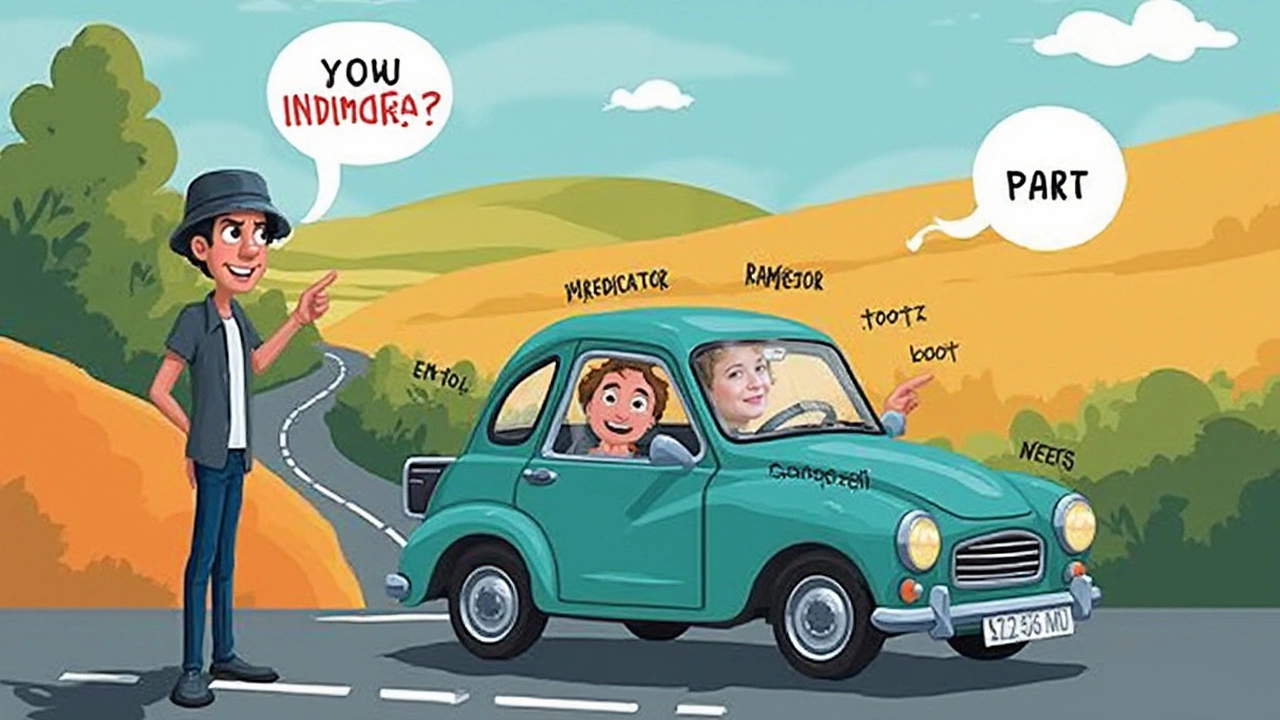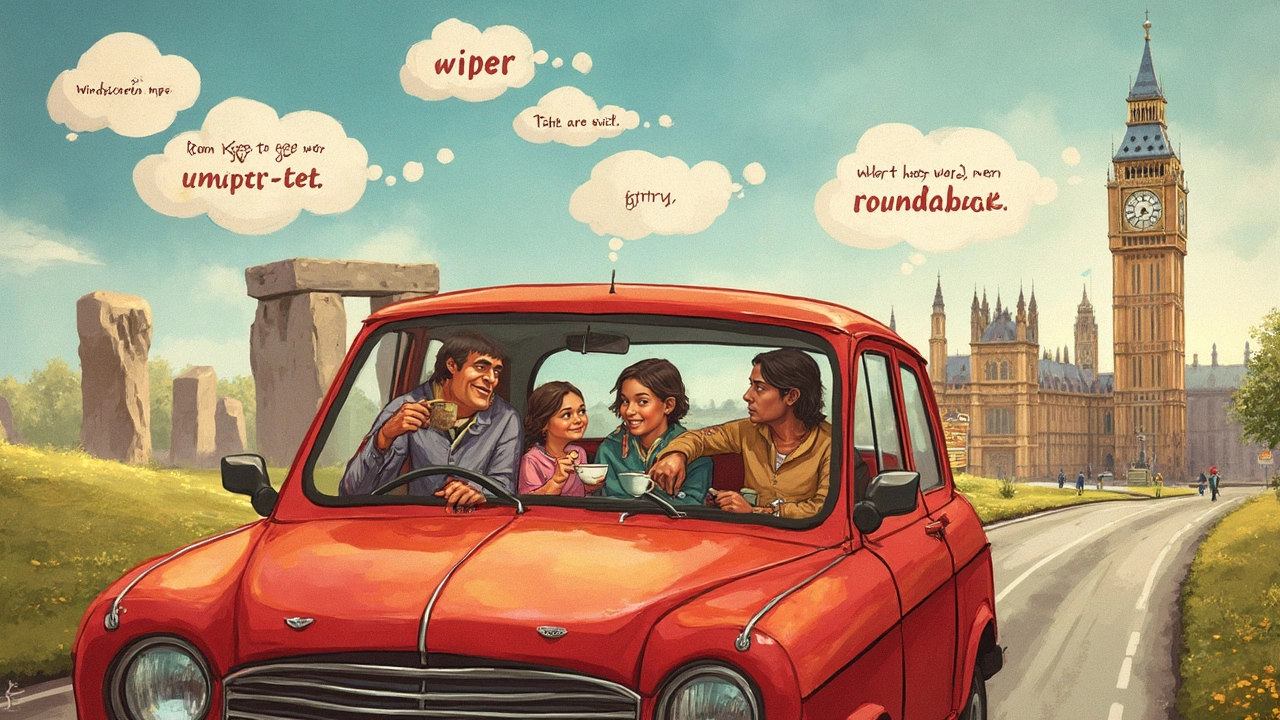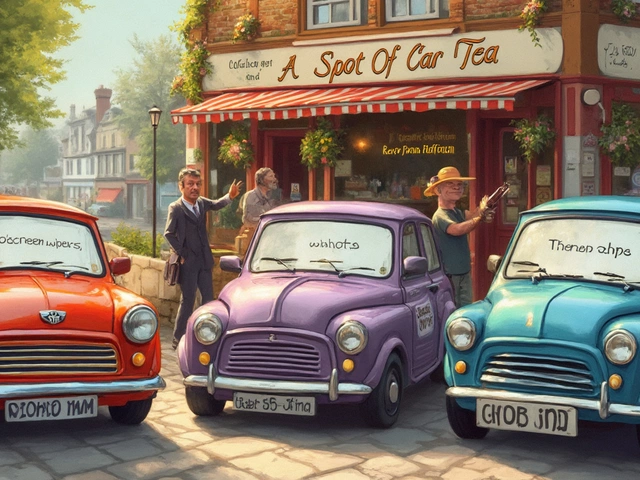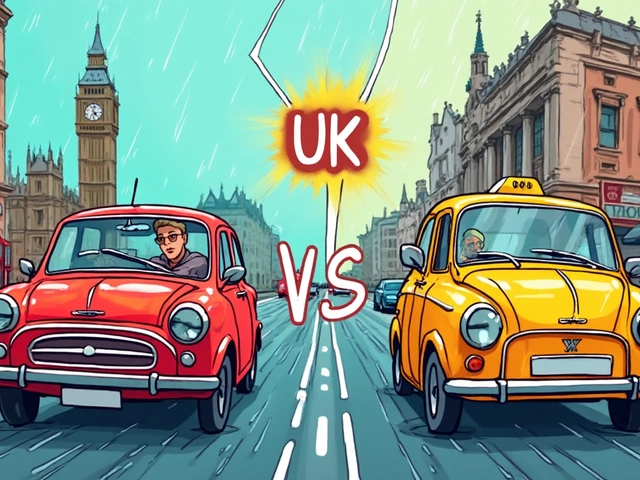So, you've got your bags packed for a trip to the UK, and you're dreaming of renting a car and hitting the open road. But wait—you might hit a snag in your adventure if you don't pick up on some local car lingo. Let's kick things off with windscreen wipers. Yes, that's the British term for what many know as windshield wipers. Sounds fancy, right? But it’s just those trusty strips of rubber that swoosh away the rain while you drive.
Why does it matter, you ask? Imagine you're in London, caught in a typical downpour, and the rental agent casually mentions the 'windscreen wipers.' You might pause, scratching your head, thinking, 'Did I miss a car upgrade?' Not to worry, it's the same gear, just with a British twist.
- Windscreen Wipers vs. Windshield Wipers
- Other British Car Part Names
- Why the Differences?
- Useful Tips for Traveling Drivers
- Fun Facts About British Cars
Windscreen Wipers vs. Windshield Wipers
Ever find yourself confused when Brits start chatting about their windscreen wipers? It’s one of those quirky differences between British and American English. In the States, you’d call them 'windshield wipers,' but across the pond, it’s 'windscreen wipers.' Both do the exact same job, swiping away rain and debris, but the name reflects more of a cultural twist.
In the UK, the term 'windscreen' refers to what Americans call the 'windshield.' Simple, right? If you’re curious about where these terms came from, it’s all about good old history. After all, the car was invented in different parts of the world at different times, and each region gave its own flair to vehicle terminology. What's fascinating is how something as standard as a car has its own language wherever you go.
If you’re planning a drive around the UK, knowing this difference might save you a few puzzled looks and misunderstandings. It's also a fun talking point if you're stuck in traffic, sharing a laugh about how one world speaks in so many ways!
Other British Car Part Names
If you're planning to take a spin in a UK rental, brushing up on British car part names might just save you from a classic 'lost in translation' moment. Some terms are downright charming, while others might leave you scratching your head.
Let's start with the basics. The "hood" of the car in the US is known as the "bonnet" in the UK. Sounds almost like a fashion accessory, doesn't it? Meanwhile, the "trunk" back in the States becomes the "boot" across the pond. Throw a suitcase in there, and it's all set!
Here's a kicker: what you call "gas" in the US is "petrol" in the UK. So, when the fuel gauge is nearing empty, and you're searching for a gas station, remember to look for 'petrol stations'. They’ll fill you up in liters rather than gallons, further adding to the foreign charm. British car parts lingo sure makes the experience feel like an adventure!
- The car's "fender" in the US is a "wing" in the UK. So, if someone mentions you have a damaged wing, they're not talking aviation!
- Thinking about what happens when you lock your car? In the UK, it's often called 'central locking' instead of 'power locks'.
- Your trusty "parking brake" is referred to as a "handbrake." You'll likely use this if you find parking on one of those charming yet steep hill roads.
- The "exhaust" in the UK might sometimes be called the "silencer." It sounds like something out of a spy movie, but it's just as mundane as you'd expect.
If you're still memorizing, keep this little cheat sheet handy. You'll sound like a local by lunchtime, impressing your co-drivers with your newfound British flair. Familiarizing yourself with these terms can really make the logistics of driving smoother, especially when needing roadside help or doing vehicle checks.

Why the Differences?
Ever wonder why Brits have their own quirky names for car parts, like windscreen wipers? It all boils down to history and culture. Back in the day, Britain and the U.S. developed their automotive industries independently. This meant each country coined their own terms for technology, tools, and parts emerging around that time. So, windscreen wipers in the UK, windshield wipers across the pond – same function, different jargon.
Language evolution plays a role too. Over time, British English and American English borrowed from each other but also grew distinct. Think of it like siblings who shared a room growing up but eventually moved into their own places with their own styles. In fact, you'll find that British English often retains older forms of words, which is why 'windscreen' harks back to an era when car windows were literally screens for the wind.
- British car parts tend to have terms that align closely with their historical origins.
- U.S. terms evolved as the automotive world became more globalized and accessible.
- Each term reflects the broader cultural preferences and linguistic trends unique to these regions.
Another fun tidbit: British terms often reveal an amusing take on car parts. For instance, they call the hood of the car a 'bonnet' and the trunk a 'boot.' It's like your car's dressing up for a day out. Whether you find these terms charmingly old-fashioned or just puzzling, they're essential for blending in on British roads.
Useful Tips for Traveling Drivers
Driving in the UK can be quite the adventure, especially if you're used to navigating on the right side of the road. Let's start with some key pointers that could turn your driving experience from nerve-racking to smooth sailing.
First things first—always remember, they drive on the left. It might sound elementary, but muscle memory is strong, and you'll need to stay alert. A little extra caution can save you from potential mishaps.
- Mind the British car parts lingo. Apart from windscreen wipers, you’ll encounter terms like 'boot' for trunk and 'bonnet' for hood. Familiarizing yourself with these can be a real lifesaver if you need roadside assistance.
- Roundabouts are everywhere. Unlike the straightforward intersections you might be used to, these require you to give way to the traffic coming from the right. Once you get the hang of it, they can actually be fun!
- Watch out for speed limits, which are in miles per hour (mph), not kilometers. The signs are there to remind you, but being aware beforehand always helps.
- If possible, opt for a GPS or a navigation app with UK maps such as Waze or Google Maps. These are super handy for avoiding traffic and unexpected detours.
- Consider getting temporary car insurance if your current one doesn't cover international driving. Trust me, dealing with insurance hassles in a foreign land is nobody's idea of fun.
Did you know that according to a recent survey, about 70% of drivers who rent cars in the UK find understanding the local road signs to be the trickiest part? Investing a bit of time in knowing what those quirky symbols mean can enhance your driving confidence immensely.
Last but not least, enjoy the countryside! The UK is blessed with some picturesque routes, and a drive through regions like the Cotswolds or the Lake District is a reward in itself. Just remember to give a friendly wave when you let another driver pass—it’s a small gesture that goes a long way!

Fun Facts About British Cars
When it comes to automobiles, the UK has some quirks that make its cars pretty interesting. For starters, British car parts may use slightly different materials and designs, given their unpredictable weather. You know, the kind of weather that really makes those windscreen wipers work overtime!
Did you know that the iconic London black cabs have a surprisingly tight turning circle? It's specifically designed to handle the city’s narrow streets and cramped corners. London cabbies definitely know how to make the most of their wheels!
Let’s not forget about tailgates. Or as they call them in the UK, 'boot lids.' Apparently, around half of UK cars are hatchbacks. This makes sense when you think about the need for extra cargo space for those scenic drives through the countryside.
| Car Type | % in UK |
|---|---|
| Hatchbacks | 50% |
| Sedans | 20% |
| SUVs | 15% |
| Others | 15% |
Another fun fact: British car manufacturers have a knack for luxury. Brands like Rolls Royce and Bentley are synonymous with style and comfort. It's no wonder these cars often feature in movies and magazines too.
So, next time you’re in the UK, keep an eye out for these uniquely British elements while out on the road. You might just appreciate how different yet interesting their car parts and designs can be!


